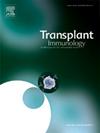Anti-HLA antibodies may be a subset of polyreactive immunoglobulins generated after viral superinfection
IF 1.4
4区 医学
Q4 IMMUNOLOGY
引用次数: 0
Abstract
Chronic rejection remains an obstacle to long-term allograft survival. Donor-specific anti-HLA antibodies (DSA) play a significant role in causing chronic antibody-mediated allograft rejection. Exposure to mismatched HLA antigens via transfusion, pregnancy, or transplanted tissue has been described in the literature as an immunogenic stimulus of anti-HLA antibodies. Yet anti-HLA antibodies also develop in the absence of traditional sensitization events and molecular mimicry has been postulated as a stimulus for these naturally occurring alloantibodies. While heterologous reactivity has been documented between virus components and allogeneic T cells, there is insufficient evidence to support the development of anti-HLA antibodies from viral components. We hypothesized that anti-HLA antibodies may develop following viral coinfection or superinfection. The objectives of this investigation included: 1) developing an in-silico algorithm to identify viral peptide components that exhibit HLA-specific homology, and 2) identifying cellular changes that take place during ischemia/reperfusion injury which could facilitate the generation of novel anti-HLA antibodies from viral sources. We developed the neoepitope transplant rejection and autoimmune disease (NETRAD) algorithm to identify amino acid sequence homology between viral envelope proteins and HLA. The algorithm integrates post-translational protein modifications that are consistent with ischemia/reperfusion injury. Seventy-two HLA-specific epitopes were demarcated as examples using this approach. In conclusion, we present in-silico evidence which supports the identification of anti-HLA antibodies as a subset of polyreactive antibodies generated from stress-modified viral envelope proteins. Remarkably, each targeted HLA epitope associated with a distinct anti-HLA antibody could be consistently attributed to a major envelope glycoprotein component of Epstein Barr virus.
Transplant Immunology manuscript # TRIM-D-24-00351.
Dryad data repository: https://doi.org/10.5061/dryad.qjq2bvqpq.
抗 HLA 抗体可能是病毒超级感染后产生的多反应性免疫球蛋白的一个子集。
慢性排斥反应仍然是同种异体移植物长期存活的障碍。供体特异性抗hla抗体(DSA)在引起慢性抗体介导的同种异体移植排斥反应中起重要作用。在文献中,通过输血、妊娠或移植组织暴露于不匹配的HLA抗原被描述为抗HLA抗体的免疫原性刺激。然而,抗hla抗体也会在没有传统致敏事件的情况下产生,分子模仿被认为是这些自然产生的同种异体抗体的刺激因素。虽然病毒成分和同种异体T细胞之间存在异源反应性,但没有足够的证据支持从病毒成分中产生抗hla抗体。我们假设抗hla抗体可能在病毒共感染或重复感染后产生。本研究的目的包括:1)开发一种计算机算法来识别具有hla特异性同源性的病毒肽成分;2)识别在缺血/再灌注损伤期间发生的细胞变化,这些变化可能有助于从病毒来源产生新的抗hla抗体。我们开发了新表位移植排斥和自身免疫性疾病(NETRAD)算法来鉴定病毒包膜蛋白和HLA之间的氨基酸序列同源性。该算法整合了与缺血/再灌注损伤一致的翻译后蛋白修饰。72个hla特异性表位被划分为使用这种方法的例子。总之,我们提出了支持hla抗体是由应激修饰病毒包膜蛋白产生的多反应性抗体的一个子集的硅证据。值得注意的是,每个与不同的抗HLA抗体相关的靶向HLA表位都可以一致地归因于爱泼斯坦巴尔病毒的主要包膜糖蛋白成分。移植免疫学论文# TRIM-D-24-00351。Dryad数据存储库:https://doi.org/10.5061/dryad.qjq2bvqpq(管理下)。
本文章由计算机程序翻译,如有差异,请以英文原文为准。
求助全文
约1分钟内获得全文
求助全文
来源期刊

Transplant immunology
医学-免疫学
CiteScore
2.10
自引率
13.30%
发文量
198
审稿时长
48 days
期刊介绍:
Transplant Immunology will publish up-to-date information on all aspects of the broad field it encompasses. The journal will be directed at (basic) scientists, tissue typers, transplant physicians and surgeons, and research and data on all immunological aspects of organ-, tissue- and (haematopoietic) stem cell transplantation are of potential interest to the readers of Transplant Immunology. Original papers, Review articles and Hypotheses will be considered for publication and submitted manuscripts will be rapidly peer-reviewed and published. They will be judged on the basis of scientific merit, originality, timeliness and quality.
 求助内容:
求助内容: 应助结果提醒方式:
应助结果提醒方式:


